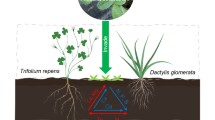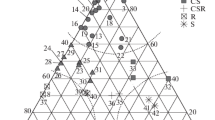Abstract
The argument that selective grazing leads to competitive replacement of palatable grasses by unpalatable grasses is based upon the assumption that the competitive ability of the palatable species is higher than the one of unpalatable species in the absence of grazing. In order to test this hypothesis we have compared the competitive ability of Stipa clarazii (palatable) and S. trichotoma (unpalatable) under field conditions, and S. clarazii and S. gynerioides (unpalatable) under greenhouse conditions. The three species are native to a temperate semi-arid grassland of central Argentina. In the field experiment, plants of both species were grown either independently or in pairs (palatable + unpalatable), protected from grazing. Shoot and seed production were measured at the end of the growing seasons of 1993, 1994 and 1995. In the greenhouse experiment, plants of both species were grown in pots, either in monoculture or in mixture, under conditions of high and low water and mineral nutrient availability. Total biomass and seed production were measured at the end of the experimental period. In both experiments the presence of the unpalatable species did not affect (P < 0.05) the productive responses of the palatable species. On the contrary, the presence of the palatable species significantly reduced (P < 0.05) the productive responses of the unpalatable species. Our results support the assumption, on which most interpretations of floristic changes induced by grazing are based, that the competitive ability of palatable grasses is higher than the one of unpalatable grasses in the absence of grazing.
Similar content being viewed by others
References
Aerts, R. 1995. The advantages of being evergreen. Trends Ecol. Evol. 10: 402-407.
Aerts, R. & Van der Peijl, M. J. 1993. A simple model to explain the dominance of low-productive perennials in nutrient-poor habitats. Oikos 66: 144-147.
Anderson, V. J. & Briske, D. D. 1995. Herbivore-induced species replacement in grasslands: Is it driven by herbivory tolerance or avoidance? Ecol. Appl. 5: 1014-1024.
Archer, S. & Smeins, F. E. 1991. Ecosystem-level Processes. In: Heitschmidt, R. K. & Stuth, J. W. (eds). Grazing management: an ecological perspective. Timber Press, Portland, Oregon, USA.
Berendse, F. 1994. Litter decomposability - a neglected component of plant fitness. J. Ecol. 82: 187-190.
Briske, D.D. 1991. Developmental morphology and physiology of grasses. In: Heitschmidt, R. K. & Stuth, J. W. (eds). Grazing management: an ecological perspective. Timber Press, Portland, Oregon, USA.
Bóo, R. M., Lindstrom, L. I., Elía, O. R. & Mayor, M. D. 1993. Botanical composition and seasonal trends of cattle diet in central Argentina. J. Range Manage. 46: 479-482.
Cabrera, A. 1976. Regiones Fitogeográficas Argentinas. In: Enciclopedia Argentina de Agricultura y Jardinería, Tomo II, Fascículo 2. Acmé, Buenos Aires, Argentina.
Cano, E. 1975. Pastizales en la región central de la provincia de La Pampa. IDIA Julio-setiembre: 1-15.
Caldwell, M.M. 1984. Plant requirements for prudent grazing. In: Developing strategies for rangeland management. Westview Pres, Boulder, Colorado, USA.
Campbell, B. D. & Grime, J. P. 1992. An experimental test of plant strategy theory. Ecology 73: 15-29.
Campbell, B. D., Grime, J. P., Mackey, J.M. L.& Jalili, A. 1991. The quest for a mechanistic understanding of resource competition in plant communities: the role of experiments. Funct. Ecol. 5: 241-253.
Chapin III, F. S., Autumn, K. & Pugnaire, F. 1993. Evolution of suites of traits in response to environmental stress. Am. Nat. 142: S78-S92.
Distel, R. & Bóo, R. 1996. Vegetation states and transitions in temperate semi-arid rangeland of Argentina. In: West, N. (ed), Proceedings of the Fifth International Rangeland Congress. Salt Lake City, Utah, USA.
Holland, E. A. & Detling, J. K. 1990. Plant response to herbivory and belowground nitrogen cycling. Ecology 71: 1040-1049.
Jones, C. G., Lawton, J. H. & Shachak, M. 1994. Organisms as ecosystem engineers. Oikos 69: 373-386.
Llorens, E. M. 1995. Viewpoint: The state and transition model applied to the herbaceous layer of Argentina's caldén forest. J. Range Manage. 48: 442-447.
Mahmoud, A. & Grime, P. J. 1976. An analysis of competitive ability in three perennial grasses. New Phytol. 77: 431-435.
Milchunas, D. G. & Lauenroth, W. K. 1993. Quantitative effects of grazing on vegetation and soils over a global range of environments. Ecol. Monogr. 63: 327-366.
Milton, S. J., Dean, W.R.J., du Plessis, M.A.& Siegfried, W.R. 1994. A conceptual model of arid rangeland degradation. Bioscience 44: 70-76.
Noy-Meir, I. & Walker, B.H. 1986. Stability and resilience in rangelands. In: Joss, P. J., Lynch, P. W. & Williams, O. B. (eds). Rangelands: a resource under seige. Aust. Acad. Sci., Canberra, Australia.
Sackville Hamilton, N. R. 1994. Replacement and additive designs for plant competition studies. J. Appl. Ecol. 31: 599-603.
Snaydon, R.W. 1994. Replacement and additive designs revisited: comments on the review paper by N. R. Sackville Hamilton. J. Appl. Ecol. 31: 784-786.
Van der Werf, A., Van Nuenen, M., Visser, A. J. & Lambers, H. 1993. Contribution of physiological and morphological plant traits to a species' competitive ability at high and low nitrogen supply. Oecologia 94: 434-440.
Wedin, D.A. 1995. Species, nitrogen, and grassland dynamics: the constraints of stuff. In: Jones, C. G. & Lawton, J. H. (eds). Linking Species & Ecosystems. Chapman & Hall, New York, USA.
Westoby, M., Walker, B. & Noy-Meir, I. 1989. Opportunistic management for rangelands not at equilibrium. J. Range Manage. 42: 266-274.
Wilson, S. D. & Tilman, D. 1995. Competitive responses of eight old-field plant species in four environments. Ecology 76: 1169- 1180.
Author information
Authors and Affiliations
Rights and permissions
About this article
Cite this article
Moretto, A.S., Distel, R.A. Competitive interactions between palatable and unpalatable grasses native to a temperate semi-arid grassland of Argentina. Plant Ecology 130, 155–161 (1997). https://doi.org/10.1023/A:1009723009012
Issue Date:
DOI: https://doi.org/10.1023/A:1009723009012




